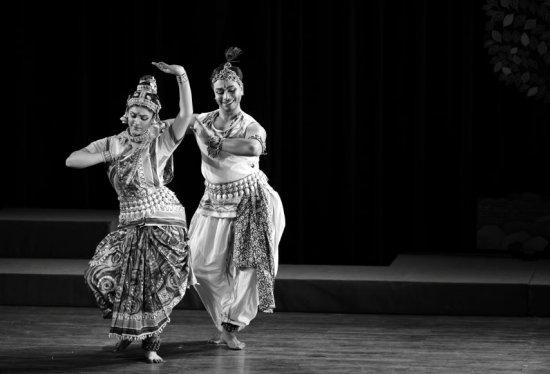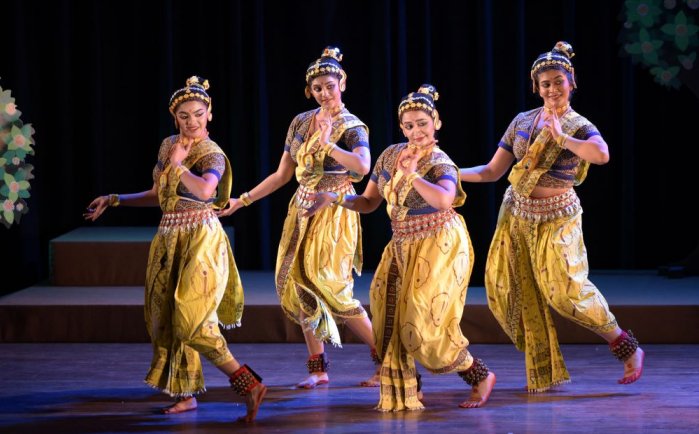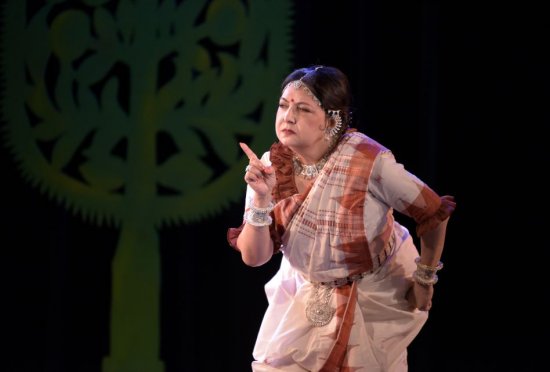
|   |

|   |
Preyashee Katha - Tapati Chowdhurie e-mail: tapatichow@yahoo.co.in Photos courtesy: Gurukul May 26, 2024 Preyashee Katha was conceived by the artistic director Sutapa Talukdar of Gurukul, the Odissi dance centre of Kolkata. It was held in the Horizon series of Indian Council for Cultural Relations at Rabindranath Tagore Centre in Kolkata on the 2nd of May. Preyashee is a Sanskrit word for lover - in this case it refers to a female lover. Our ancient literature and art forms have given this word many shades of meaning. Sutapa Talukdar has explored a few of these connotations and hues of who a Preyashee is and how she is defined and understood. Taking Krishna as the eternal hero and the eternal object of devotion and love, Sutapa and her team dwelt on the Nayika Bheda of Bharata's Natya Shastra in the first half of her Katha and then moved on to the second half which dwelt on Chautisha form of Odiya poetry where the folks of Vrindavan moaned the loss of Krishna, when he was leaving the town for Mathura.  Radha and Krishna Sage Bharata in his Natya Shastra has universally classified all men and women as Uttama, Madhyama and Adhama. The hero is the nayaka and the heroine is nayika. Preyashee Katha's performers used three poems to delineate the qualities of the nayikas. To start with, a piece from the work of poet Vidyapathi was selected to showcase the love and longing of a Uttama nayika, who sees the vision of a young man with rippling dark hair walking down the river bank at dusk, which has left a deep imprint on her, which seemed to her to be like a dream. As an Uttama nayika she describes him to her friend, with delicate poetry and sophisticated metaphor. Her expression of the immediate and intense desires invoked in her by the sight of the youth was ethereal and almost spiritual, though rooted in the imagery of everyday life. She is Radha, Krishna's eternal partner and the earthy and suggestive tones of the Madhyama and Adhama nayikas are not for her. It is her nature to describe the young man in great poetic beauty, likening him to numerous metaphors from nature, like lotus feet, lips as red as fresh fruits, nails like the crescent moon, thighs as firm as young saplings, palms as bright as young leaves, eyes as bright as birds. She tells her friend about the valorous man, who was walking down the river side, when she saw him. Radha pleads to her friend to help her find a way out of the fainting fits, which this vision has brought on. The Natya Shastra gives the Madhyama nayika a middle position as the word suggests. In Sutapa Talukdar's choreography the Madhyama nayika's description of Sri Krishna is portrayed befittingly through an Odiya song. Madhyama nayika sees him as more human rather than godlike and her recounting of his beauty and his virtues are more rooted in physicality. The language and metaphors are also more substantial, corporeal and material. She describes his lips, the shining teeth and the 'kaustubh' necklace on his chest. His shining eyes and deep heroism has cast cupid's spell on her. 'Dekhibo para sare' was the beautiful song written by the Odiya poet Narayana which was chosen to unfold the characteristics of the Madhyama nayika. The call of Krishna's flute mesmerizes her day and night. Though she venerates him as a god too, like the Uttama nayika, her approach is substantially different. She is not as self-controlled as the Uttama nayika, she is also not wholly without self-restraint like the Adhama nayika. She beckons her friends to come and see how beautifully their lord is dressed and sways his gait to entrance Gopis with his hypnotic gaze. It seems as if Kamadev is striking arrows into their hearts. The Gopis are under his spell, they watch his lips made red with the betel leaves he is chewing.  The Nayikas For the portrayal of Adhama nayika, Sutapa Talukdar had chosen the words of an anonymous poet. The lyric is in a comic and devotional style. It is a true description of the Adhama nayika's behaviour and attitude to her lord. The language of the nayika and her earthy references are typical of a nayika who expresses herself very naturally, without sophistication or self-restraint. The Gopis accuse Krishna of always planning and scheming to tease them. While doing so they display typical adhama characteristics and threaten Krishna to pour buttermilk on his head, take away his flute which he uses as the arrows of Cupid to target their hearts and flirt with married women, promising to tell Kamsa about it. Krishna's playful activities and the mock anger of the Gopis melt as they give up teasing him aggressively for the fun of it. After a period of momentary silence, confused Krishna retaliates. The nayikas brand him of being flirtatious. However all ends well on a playful note and they continue to be friends. The performers of the piece delivered to the audience the liveliness of the characters, their racy passions and slightly coarse emotions ending with the eternal spirit of devotion that is the hallmark of all literature on Krishna and his Gopis. The concluding piece of Preyashee Katha was from Chautisha, which is a unique genre in Indian literature. The name comes from the fact that every Chautisha has thirty four letters, which is the reason why these songs are also referred to as Chautisha. In this form, a charana is composed by starting each line with letters of the alphabet in a chronological order. Not just a line, sometimes a whole pada is written starting with one alphabet. Popular in medieval Indian literature, Chautisha can be found in literature of many languages such as Sanskrit, Bengali, Odiya, Urdu. The piece chosen was by Kavi Samrat Bhakta Charan Das - born in the 18th century and died in the first decades of the 19th century. The Chautishas that Talukdar has worked on were from these eras. Her choice of Chautisha for a dance piece shows her spirit of walking on untrodden and unknown paths. Sutapa chose Chautisha mainly because it is an unexplored genre and she firmly believes that it has a hypnotic ability to touch a chord in our hearts. Its exquisite and lyrical metaphors are unique. Though metaphors are common in art, Chautisha's usage of metaphors are mesmerizing and fascinating and leaves the listeners spellbound. The chosen verse is a beautiful eulogy to the two Yadava brothers Krishna and Balaram, who have set off on a journey to defeat Kamsa, the king of Mathura. The description of their valour is hyperbolic as is the description of grief of the villagers, Gopis, milkmaids and common folk. They tell of their love for the Blue God, their sorrow at the imminent parting and their wish to honour him and show their deep affection in various ways. They swayed the audience to share their feelings and that is what made the scene spectacular.  Gopis bidding farewell to Krishna Mobs of the town summoned their friends to join them on this emotional journey of farewell, recounting Krishna's tales of valour from his slaying of the demon Poothana as a child to the lifting of the Govardhan mountain. They praise his beauty; they describe Yashoda's grief at the loss of her beloved son. This retelling in the words of the poet is a passionate story of the Yatra of the villagers and common folk who are heartbroken with Krishna leaving the village. The chariots on the stage used as props were a symbolic representation of the journey of the brothers followed by the throng of devoted villagers, chanting and singing all along the way was heart wrenching. The people described the brothers as Ganga and Yamuna and spoke of Krishna's valour. Their admiration for Krishna made them remember all his noble deeds reproduced in the language of dance. They did his seva forgetting everything, starting from wiping his perspiration from his forehead, forgetting the aspersions thrown on their characters, was vividly etched. Sutapa Talukdar's disciples who filled the hearts of the audience with rasa were Oishanee Bhattacharjee, Ishani Boral, Priyosmita Poddar, Anushka Banerjee, Swagatalaxmi Saha, Srijoni Nandi,Sreyashi Sarkar, Sandhini Sengupta, Anushka Majumder, Arshia Talukdar, Aishani Talukdar, Sipra Mal, Sourav Samanta, Subhabrata Chatterjee and Souvik Kumar Modak. Music composition was by Ramahari Das, mardala was by Dhaneswat Swain, vocal rendition was by Sukanta Kundu, Jasaswini Nayek, Sristiswarupa Mishra and Ramahari Das. Set designer Umesh Chandra Bera and team, Kamal Dhar and team displayed their talents by their wonderful set design .The concept was Sutapa Talukdar's while Ramahari Das and Dhaneswar Swain gave life to Preyashee Katha through their exceptional perception and musical prowess. Sutapa Talukdar confessed that she was helped by the music composer to bring to light, through his music, the essence of what she had in mind and translated them meaningfully to brilliant pieces of music.  Sutapa Talukdar In a brief talk after the show she spoke to yours truly which held a torch to the kind of methodology she follows from A to Z regarding the selection of her piece, which consists of reading, researching, thinking and finally narrowing it down to the piece she intends to work on. She said she carries a notebook wherever she goes, so that the random ideas that flash in her mind, be it a story piece, a dance movement, a costume idea, she notes them down. Technology, she said, has made things easier. "I now voice record my thoughts on my mobile", she said. As for her choreography, she does not think about a movement from beforehand, she creates movements when she is with her students. It all comes to her on the spot. She believes that if one is honest to her art, the early days of learning remains from which one can draw and create amazing pieces. Years of observation of other dance forms has shaped her aesthetics. As far as her memory goes, no one has danced on Chautisha. Many an Odiya music composer has said that Chautisha is not appropriate as a dance language. Preyashee Katha was designed with two distinctive halves. The first half dealt with Uttama, Madhyama and Adhama Nayikas as delineated in the Natya Sashtra. The lyric chosen to represent Uttama nayika was written by the famous poet Vidyapati in Maithili. Vidyapati, also known as the Maithili Kavi Kokil, was a great influence on poets for his writings in Maithili, Sanskrit and other Eastern Indian languages. The lyric, Dekhibo Pora performed by Madhyama nayika was written by Narayana, in the Odiya language. The lyric to portray Adhama nayika was by an unknown writer of Vaishnab Padabali in the ancient Bengali language. Regarding the selection of music by Ramahari Das, Sutapa Talukdar said "The musical style used by Ramahari Das is Odiya. I feel the music that he has created here is very different from what he usually creates. If you notice, the music here is much more dramatic. It accentuates every movement, identifies with every emotion and breathes life into every visual, thus creating a drama that is so life-like, yet grand. It is as if he has played with the lyrical notes to blend imagination and reality. The same can be said about Dhaneswar Swain. He played the mardala in a way that the audience could actually feel every mood, every twist of the piece, so much so that it tugged at listeners' hearts in a very real way." About her dance choreography she said, "As a matter of principle I have always presented the pure form or the original choreography while I am performing a piece of my Guru Kelucharan Mohapatra. But as an artiste, when I am creating my own piece, I go beyond the learnt material. All artistes have their own aesthetics, their own thoughts when creating their choreography. It is this 'self' that a dancer brings to a piece, is what makes the choreography unique. Here, the boundaries of the learnt materials have to be overcome. Knowingly or unknowingly, I always create my own style when doing my own choreography. If you notice, I use a lot of variations in my costume, set and props. The idea behind this is to make my art more accessible and acceptable to my audience; I want to create a lasting connection with them and make them feel attached to my art. The subject of Adhama demands an approach that is rough and unpolished with a healthy dose of comedy. To bring in this element of rawness, I brought Odissi, Mayurbhanj Chhau and Kandyan dance together to develop the character type of Adhama." Sutapa Talukdar is a renowned Odissi performer nurtured by Guru Kelucharan Mohapatra. In fact she was the chosen one to take on the role of Krishna when Guruji was choreographing Geeta Govinda eons ago. It was a hit production. She excelled in her role as Krishna. Today she is a guru and a choreographer par excellence.  Tapati Chowdhurie trained under Guru Gopinath in Madras and was briefly with International Centre for Kathakali in New Delhi. Presently, she is a freelance writer on the performing arts. |